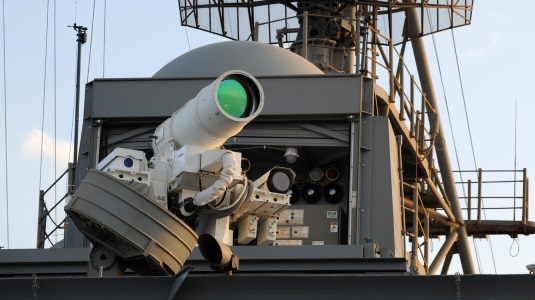
The Office of Naval Research (ONR) said that the laser weapon system (LaWS) – a cutting-edge weapon that brings significant new capabilities to America's Sailors and Marines – was for the first time successfully deployed and operated aboard a naval vessel in the Arabian Gulf. This sounds like the first iteration of the Reagan era defense plan called the Strategic Defense Initiative or Star Wars by others. Except this one is real.
The operational demonstrations, which took place from September to November aboard USS Ponce, were historic not only because they showed a laser weapon working aboard a deployed U.S. Navy ship, but also because LaWS operated seamlessly with existing ship defense systems. The navy says that this could be affordable (whatever that means) and will play a vital role in the future of naval combat operations. The laser-weapons system was able to lock-on and destroy assigned targets.
During the tests, LaWS – a collaborative effort between ONR, Naval Sea Systems Command, Naval Research Laboratory, Naval Surface Warfare Center Dahlgren Division and industry partners — hit targets mounted aboard a speeding oncoming small boat, shot a Scan Eagle unmanned aerial vehicle (UAV) out of the sky, and destroyed other moving targets at sea.
Play video: https://youtube.com/watch?v=sbjXXRfwrHg
The system is operated by a video-game like controller, and can address multiple threats using a range of escalating options, from non-lethal measures such as optical “dazzling” and disabling, to lethal destruction if necessary. It could prove to be a pivotal asset against what are termed “asymmetric threats,” which include small attack boats and UAVs.
Data regarding accuracy, lethality and other factors from the Ponce deployment will guide the development of weapons under ONR's Solid-State Laser-Technology Maturation program. Under this program, industry teams have been selected to develop cost-effective, combat-ready laser prototypes that could be installed on vessels such as guided-missile destroyers and the Littoral Combat Ship in the early 2020s.
Researchers say the revolutionary technology breakthroughs demonstrated by LaWS will ultimately benefit not only U.S. Navy surface ships, but also airborne and ground-based weapon systems.
While laser weapons offer new levels of precision and speed for naval warfighters, they also bring increased safety for ships and crews, as lasers are not dependent on the traditional propellant and gunpowder-based ordnance found on ships. Lasers run on electricity and can be fired as long as there is power.
“At less than a dollar per shot, there's no question about the value LaWS provides,” said Klunder. “With affordability a serious concern for our defense budgets, this will more effectively manage resources to ensure our Sailors and Marines are never in a fair fight.”
The Navy already has demonstrated the effectiveness of lasers in a variety of maritime settings. In a 2011 demonstration, a laser was used to defeat multiple small boat threats from a destroyer. In 2012, LaWS downed several unmanned aircraft in tests during naval exercises. Specific details on next steps and timeframes are being determined as the data from the current demonstrations are analyzed.
The announcement confirms continued significant progress on directed-energy weapons, and meets the timeframe announced by Chief of Naval Operations Adm. Jonathan Greenert at the 2013 Sea-Air-Space Expo. Greenert will be the opening speaker at the upcoming Naval Future Force Science and Technology EXPO in February 2015, where many of the innovative technologies coming to fruition for the Navy and Marine Corps will be on display.
About the Office of Naval Research
The Department of the Navy's Office of Naval Research (ONR) provides the science and technology necessary to maintain the Navy and Marine Corps' technological advantage. Through its affiliates, ONR is a leader in science and technology with engagement in 50 states, 70 countries, 1,035 institutions of higher learning and 914 industry partners. ONR employs approximately 1,400 people, comprising uniformed, civilian and contract personnel, with additional employees at the Naval Research Lab in Washington, D.C.
Advertisement





